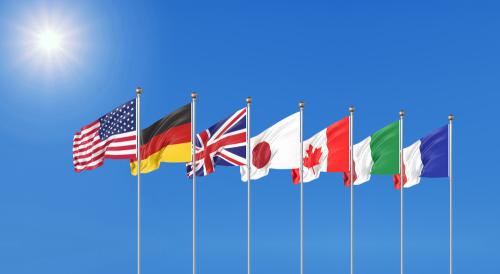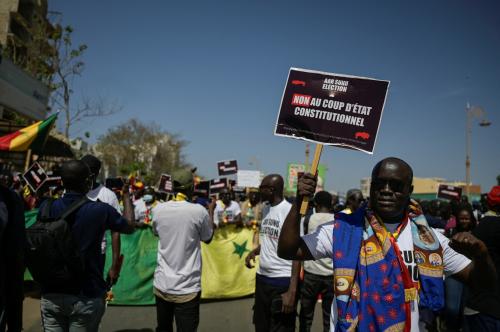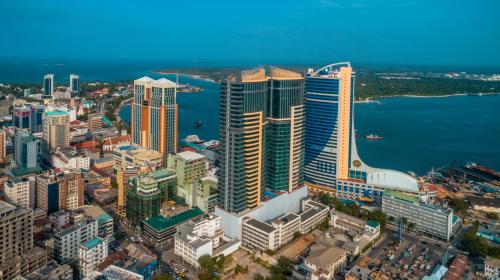Emerging market economies, like advanced economies, suffered a strong increase in inflation at the onset of the COVID-19 pandemic, but their policymakers raised interest rates much sooner. In contrast to earlier episodes, emerging markets have proven impressively resilient. On April 22, 2024, the Hutchins Center hosted a conference about lessons learned from the COVID inflation in emerging market and developing economies (EMDEs). Antonio Fatás of INSEAD presented on emerging Asia, Refet Gürkaynak of Bilkent University presented on emerging Europe, and Juan Pablo Medina of Universidad Adolfo Ibáñez presented on emerging Latin America. Conference drafts, slides, discussant presentations, and a recording of the conference are available on the Brookings website.
Here is a summary of their work.
Emerging Asia
Inflation in emerging and developing Asia was muted compared to advanced economies and other EMDEs. Inflation fell below 2% as the pandemic hit, rose to a peak of just over 4%, and has since fallen to historically low levels. Chinese inflation, which was very low during this period, weighs heavily into Asian EMDE statistics; nevertheless, inflation excluding China still showed a small runup by historical standards. Fatás identified a weak recovery, unconventional fiscal policies like price controls and subsidies, and stable exchange rates as the primary forces behind low inflation in Asian EMDEs. Since 2020, Asian EMDEs excluding China have experienced a persistent negative output gap because of limited fiscal support and delayed reopening. A measure of fiscal impulse showed that Asian EMDEs provided stimulus in line with other EMDEs, although significantly less than advanced economies. While other economies were beginning to ease pandemic restrictions in 2021, Asian EMDEs remained stringent into 2022. A combination of weak fiscal stimulus and pandemic restrictions weighed on output and inflation. Unconventional fiscal policy played an important role in taming food inflation. India, Indonesia, and Malaysia imposed export bans on key food products, and Malaysia and Thailand imposed price controls on certain foods and farm inputs. Nations also subsidized food, reducing its apparent cost in the CPI. These subsidies were largest in Asian EMDEs, approaching 1% of GDP versus 0.1% of GDP in emerging and developing Latin America. Asian EMDE central banks raised rates before the advanced economies, although they did not hike as much as other EMDE central banks, perhaps because of the large negative output gap and weaker inflation pressure. Exchange rates were the most pronounced transmission mechanism of monetary policy: Nominal effective exchange rates for Asian EMDEs largely held steady or appreciated, which helped restrain import prices and signaled well-anchored inflation expectations.
Emerging Europe
Inflation in European EMDEs was stable through the first year of the pandemic before rising sharply in 2021 and 2022. Inflation peaked around 15% in early 2023 and has since fallen to just above 5%. Gürkaynak attributes the shared European EMDE experience to common commodity price shocks (mostly energy) and supply chain disruptions. Most nations in the sample experienced very similar timing and intensity of inflation despite different policy frameworks. Furthermore, the common movement of headline inflation explains over 90% of the variation across countries. The author shows a strong positive relationship between reliance on imported energy and core inflation (which excludes the direct effects of higher energy prices), suggesting that non-energy inflation was largely driven by passthrough from high global energy prices. Gürkaynak builds on this result by showing that food and energy prices explain more than half the variation of core inflation in 2021 and 2022, compared to almost no explanatory power before the pandemic. Among European EMDEs with floating exchange rates, appreciation or depreciation vis-à-vis the dollar strongly predicted headline inflation. The Albanian lek appreciated over the period owing to strong financial inflows, tourism revenue, and remittances, while Albania enjoyed the lowest headline inflation among the sample. On the other hand, Hungary pursued expansionary fiscal and monetary policy into 2022, which spurred high inflation and depressed the value of the Hungarian forint. Inflation in Turkey was unlike anything in the rest of Europe: The headline rate steadily rose from 10% to 20% over 2020 and 2021 before skyrocketing to a peak near 85% in late 2022. Gürkaynak described Turkey as evidence that policy matters; in this case, bad policy produced bad outcomes. Turkish inflation has fallen somewhat from the recent peak but remains well above pre-pandemic rates. Gürkaynak observed that political meddling with the Central Bank of Turkey is the obvious culprit. President Erdoğan replaced the Bank’s leadership four times since the pandemic, eventually finding a governor who was pliable enough to lower rates in late 2021 when inflation was more than three times above target. Political pressure on the bank eased after the 2023 Turkish general election, allowing them to raise the policy rate and begin fighting inflation.
Emerging Latin America
Emerging and developing Latin American economies experienced headline inflation dynamics remarkably similar to those of advanced economies since 2020. Inflation fell modestly at the outset of the pandemic before climbing to a peak just under 10%, mirroring the timing of inflation in advanced economies. But these similarities hide one crucial difference: Energy inflation in Latin American EMDEs was much lower than advanced economies. A simple Phillips curve estimation showed that inflation expectations were the primary driver of core services inflation, passing through to prices almost one-to-one. The same estimation on core goods suggests that inflation persistence and demand effects pushed up core goods inflation, while relative price adjustments from core services helped restrain core goods prices. Medina and Wlasiuk find that inflation persistence explains around half of core goods inflation in Latin American EMDEs over 2021 and 2022 (as opposed to roughly 15% in advanced economies), with global factors also playing a major role. Impulse response exercises showed that core inflation in Latin American EMDEs is more sensitive to energy shocks than in advanced economies, meaning headline inflation would have likely been worse if not for muted energy inflation. Simple Taylor rules suggest that central banks in Latin American EMDEs respond aggressively to rising inflation expectations, increasing the policy rate slightly more than one-to-one with expected inflation, much more than advanced economies. Medina and Wlasiuk also show that the stance of U.S. monetary policy is almost as important as the stance of Latin American monetary policy in determining future policy changes, which helps explain why Latin American EMDEs have been slow to lower policy rates.
-
Acknowledgements and disclosures
The Brookings Institution is financed through the support of a diverse array of foundations, corporations, governments, individuals, as well as an endowment. A list of donors can be found in our annual reports published online here. The findings, interpretations, and conclusions in this report are solely those of its author(s) and are not influenced by any donation.






Commentary
The COVID-19 inflation episode: Lessons from emerging Asia, Europe, and Latin America
April 30, 2024